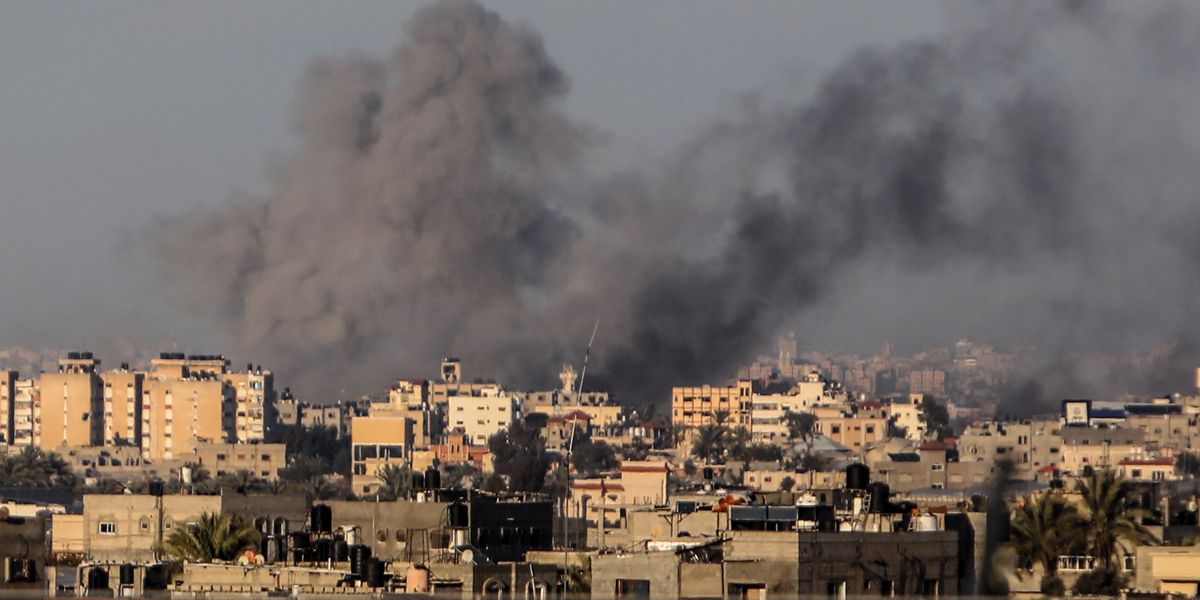In mid-December, the Israeli army discovered the bodies of three of the hostages kidnapped from southern Israel to the Gaza Strip on October 7: the soldiers Ron Sherman and Nik Beizer, and the civilian Elia Toledano. Their families were initially informed that the three men had been killed in Hamas captivity, but Maayan, the mother of Sherman, soon declared otherwise.
“Ron was indeed murdered,” she wrote on her Facebook page on Jan. 16, but “not by Hamas.” Instead, she asserted, her son was killed by “bombings with poisonous gasses.”
Maayan made her claim after reading the inconclusive findings of a pathology report, presented to her by a delegation from the Israeli army’s casualties department and the 551st brigade, whose soldiers recovered Sherman’s body from Gaza. “The delegation told us that they don’t rule out gas poisoning as a result of IDF bombings, but they’re not certain,” she told +972 Magazine and Local Call.
According to two Israeli security sources who spoke to +972 and Local Call on the condition of anonymity, this wouldn’t be the first time that Israeli airstrikes targeting Hamas’ network of underground tunnels in Gaza have killed people in this way. The army, they say, is well aware that bombs exploding in tunnels can disperse toxic gasses such as carbon monoxide.
In May 2021, for example, amid its broader assault named “Operation Guardian of the Walls,” the Israeli army launched a specific attack on Hamas’ tunnel network which it called “Operation Lightning Strike.” Gadi Eizenkot, who was the IDF Chief of Staff when the operation was planned and is now a member of Israel’s war cabinet, said later that the operation was intended to “turn the tunnels into a death trap” and kill hundreds of Hamas members.
During those attacks, which ultimately killed only a few dozen Hamas members, those hiding in tunnels were killed “not only from a bomb that hit them, but also from the fact that the bombings release gasses inside the tunnels,” a source told +972 and Local Call.
The source explained that the army did not use a chemical or biological warhead, but rather discovered that certain bombs penetrating the tunnels could, as a byproduct, spread toxic gas “over a long distance” in a closed compound. A second source confirmed this, adding that tests have been conducted in the military on the subject which have shown that inhaling these gasses in confined spaces is lethal.
+972 and Local Call could not confirm whether suffocation by toxic gas was a deliberate tactic used by the Israeli army in the current war to kill Hamas members hiding in tunnels.
In response to these allegations, the IDF Spokesperson told +972 and Local Call that the army “uses legal means of warfare only, in accordance with international law. The IDF did not in the past, and does not currently, use byproducts of bombings to harm its targets.”
‘Israelis and Palestinians were equal — both lives were disregarded’
The Israeli army announced earlier this month that the bodies of Ron Sherman and the other two hostages were found near the site of an underground tunnel in which the commander of Hamas’ northern Gaza brigade, Ahmed Ghandour, was assassinated in an Israeli airstrike in mid-November. Maayan accuses the Israeli military of knowingly killing her son in the strike to assassinate Ghandour.
An Israeli security source privy to information about the attack told +972 and Local Call that they did not know if the army suspected that there were Israeli hostages being held near Ghandour. But in order to kill the Hamas commander, the source said, the army bombed a building full of Palestinian civilians, knowingly killing dozens of them.
“Ghandour was under a very large building,” the source said. “We bombed knowing that the entire building would collapse. Many civilians were killed. But Ghandour wasn’t there. They missed. It took a second strike to kill him, also with a lot of collateral damage.”
IDF Spokesperson Daniel Hagari asserted that “the IDF did not know about the presence of hostages in the area.” He made similar remarks again after Hamas released a video in which the hostage Noa Argamani states that two of the hostages with whom she was being held were killed in an airstrike: “We [the army] do not attack places where we know there may be hostages,” Hagari said.
However, Hagari’s statements are inconsistent with the testimony of a senior security source, which is revealed here for the first time. The source told +972 and Local Call that during the first weeks of the war, the Israeli army systematically targeted Palestinians defined as “kidnappers” — those who abducted Israelis during the Hamas-led October 7 attack — with its bombings, despite a concern that there were hostages being held next to them. According to the source, Israeli abductees were “certainly hit” in these bombings; only later did this policy change.
“We bombed Palestinians suspected of being kidnappers,” the source said. “We found such suspects and we bombed them. And it was surreal, because you see in the identification of the person you are bombing that he is a ‘suspected kidnapper’ of Israelis, meaning that there is a chance there are hostages next to him. In retrospect, we know that many Israelis were held underground. But for sure, mistakes happened and we bombed hostages.”
The decision to bomb kidnappers, the source suspected, was not made at the military level. “This is the political echelon, in my opinion,” they explained. “We bombed a lot of kidnappers. More than a few dozen, and less than a hundred. Absurdly, Israeli and Palestinian civilians were equal there — both of their lives were disregarded.”
Only later in the war did the army’s prisoner of war and missing persons department inform them of the areas that they should not strike, due to fear that hostages would be harmed. “At the start of the war, this didn’t happen,” the source said. “There was no protocol about the hostages. They weren’t taken into account.
“I remember leaving the army base for the first time two or three weeks [into the war], and realizing that there were demonstrations about the hostages and that everyone here was talking about this issue,” the source continued. “And it was surreal for me, because it wasn’t until I went home that I really found out their names and how many people were kidnapped.”
The source explained that the Palestinians who were targeted because they were suspected kidnappers were not necessarily holding Israelis in their homes, but that this was likely; no checks were conducted before striking them. “We weren’t dealing with that at all at the start of the war,” they said. “The atmosphere was very painful and vengeful. We would bomb any Palestinian kidnapper.”
The source’s testimony is relevant only to the initial stages of Israel’s Gaza onslaught. In an investigation last month by +972 and Local Call, three intelligence sources confirmed that bombings were not carried out by the army if they would knowingly kill hostages, but in many cases the intelligence picture was incomplete.
‘The state sacrificed them twice’
After the Israeli army initially claimed that the three hostages were killed by Hamas, pathology reports on Ron Sherman and Nik Beizer’s bodies found no external signs of injury, such as bullet marks or bone fractures. Hagari himself stated that “at this stage it is not possible to rule out or confirm that they were killed as a result of suffocation, strangulation, poisoning, or the consequences of an IDF attack, or a Hamas operation.”
Maayan, Sherman’s mother, received a detailed report from the army after the examination of her son’s body, which also included a CT scan. “There are no fractures, no gunshot wounds, no dry blows,” she explained. According to Maayan, the head of the IDF Personnel Directorate told the family on Jan. 19 that “the matter is closed” and the army would not be conducting any further investigations.
Daniel Solomon, a doctor who has treated trauma patients who suffocated from gas or smoke, said that due to the fact that so much time had elapsed between the time of death and the recovery of the bodies, it could prove difficult to identify post-mortem signs of suffocation from carbon monoxide — such as edema in the vocal cords, burns in the airways, or tissue damage.
Katia, Beizer’s mother, told +972 and Local Call that the army informed them that the three men were being held in the same tunnel that Ghandour was hiding in when the army carried out its attack. “The [military] intelligence told us that [their deaths] could have been the result of the bomb that killed Ghandour, from the gasses and the blast, but that they don’t know.
“I demand that they continue the investigation,” Katia went on. “I told them I wouldn’t let them stop. After all, we were constantly told, in meetings with military and government officials, that they suspected there were hostages [being held] near senior Hamas figures. So if you know and suspect that there are hostages around, even if you don’t know who exactly, how can it be that you bombed?”
Maayan said that three weeks after her son was abducted, intelligence officials informed the family that “there are indications that he is alive and that they know where he is.” During the shiva (the seven-day Jewish mourning ritual) held after Sherman’s body was recovered in December, Maj. Gen. Ghassan Alian — the head of the Coordinator of Government Activities in the Territories (COGAT) — told her that he and Nitzan Alon, who is in charge of prisoners of war and missing persons, “knew at any given moment where Ron and Nik were,” and so was surprised to hear about their deaths.
That’s why Maayan accuses the military of killing her son for the sake of killing Ghandour. “Somebody is lying here,” she said. “It is clear to me that my son was sacrificed. I ask myself how they would act if it was Bibi [Netanyahu]’s son there, and not Ron. We underwent months of torture.”
“My only question is my son’s cause of death,” Katia said. “I want to know how it happened and when it happened. We don’t even know the dates. The state sacrificed them not once, but twice: first when they were abducted from their military base, which is supposed to be safe, and I called everyone possible and nobody saved them. And second when they were in captivity, and the army didn’t bring them back alive.”
In response to the allegations raised in this article, the IDF Spokesman stated: “The IDF shares the families’ grief for the difficult loss, and will continue to support them. IDF representatives have given the families all the verified information that the IDF has, and will continue to do so.
“The lives of the abductees are a leading value in considerations of the decision-makers and therefore the IDF does not attack areas where there are indications or estimates that hostages are present. It should be emphasized that the IDF did not have information about the presence of hostages in the tunnel of Hamas’ northern brigade commander at the time of the attack.
“The attack in which the commander of the northern brigade was eliminated was approved in accordance with the relevant operational procedures. It should be emphasized that the scope of the estimated harm to civilians as part of the attack mentioned in your request is completely unfounded. The claims regarding the attacks on kidnappers’ houses are also false.”
This article has been republished with permission from +972 Magazine in conjunction with Local Call.















